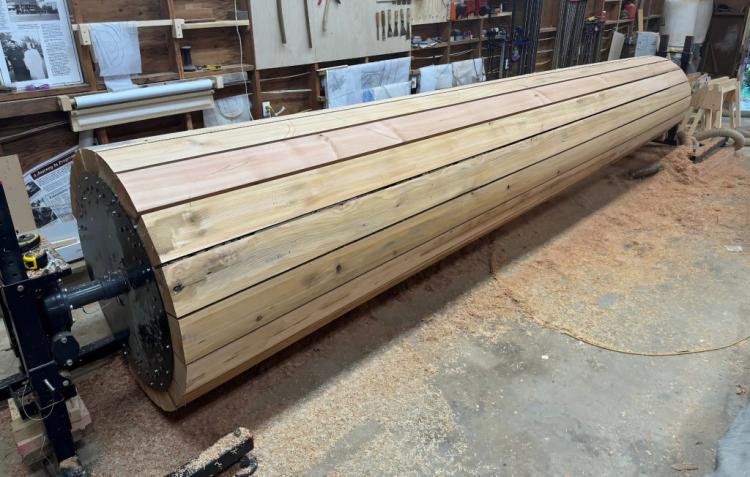Camosun Innovates, the applied research and business innovation arm of Camosun College, has developed ground-breaking technology that bridges traditional Indigenous art practices with modern engineering solutions, enabling totem pole carving using sustainable second-growth cedar.

Totem 2.0 carving apparatus
The innovative apparatus, originally imagined by renowned Indigenous artist Carey Newman (Hayalthkin'geme) and designed in consultation with him, allows carvers to work with multiple beams of second-growth cedar instead of rare old-growth logs.
What began as a sketch on paper evolved into a fully engineered solution that maintains the integrity of traditional carving methods while addressing modern environmental concerns.
"Several years ago, Richard Gale invited me for a tour of Camosun Innovates," Newman recalls. "Seeing all the equipment and diverse projects they were working on got me thinking about how we might work together."
The project, which Newman calls 'Totem 2.0', emerged from his deep commitment to preserving old-growth trees while advancing traditional art forms.
"Working with the student team who designed the rotating mechanism was an amazing experience, as were all of the conversations with faculty and staff about how to build the rest of this mechanism," Newman reflects. "After 10 years of dreaming up, designing and building this apparatus, Totem 2.0 is finally assembled and whenever I spend time carving, I am filled with the excitement of trying something new and different."
Camosun Innovates has developed two versions of the system: the original prototype, designed specifically for Newman's work with second-growth timbers, and another engineered to support traditional old-growth log carving with a capacity of up to 14,000 pounds.
"Our engineering solutions often focus on enhancing business and industry efficiency and productivity, supporting sustainability and green innovations," explains Dr. Richard Gale, Director of Camosun Innovates. "This project brings that commitment to a new level. Our priorities were to address the engineering challenges in a way that would maintain the integrity of the art form, respect the cultural contexts of the carver, and support Carey's vision of a more environmentally sustainable process. The technology developed doesn't change traditional methods - it quite literally supports them in a new way."
The custom-designed carving apparatus features a sophisticated rotation mechanism that allows carvers to position source timber for access from any angle - a significant ergonomic innovation. The apparatus has been intentionally designed so that it can be disassembled to fit in a pickup truck for easy transport, facilitating use by multiple artists and communities.
"Totem 2.0 has already sparked interest from other artists and indigenous communities," notes Dr. Gale. "It addresses concerns about old-growth harvesting, while helping to make the carving process more accessible for those with mobility challenges."
The original project, funded through a two-year grant from the Natural Sciences and Engineering Research Council (NSERC) College and Community Social Innovation fund, represents a significant investment in preserving and sustaining Indigenous art practices.
This project exemplifies Camosun Innovates' commitment to supporting Indigenous communities through technological innovation that respects and preserves the integrity of traditional beliefs and practices. It is also a key feature of the Camosun College commitment to honouring and promoting indigenous engagement and resurgence.











